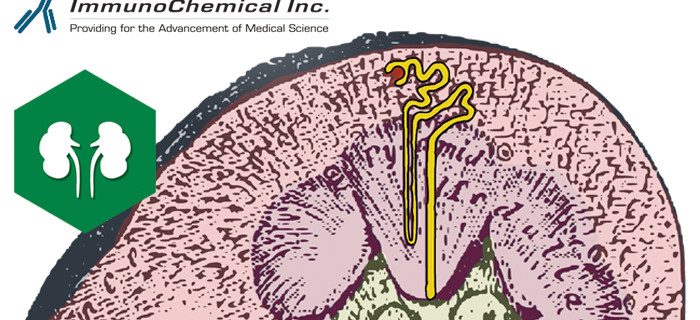Cystatin C AssayNotes
Open full Cystatin C AssayNotes pdf.
Cystatin C is a low molecular weight (13.4 kDa) cytoplasmic protein functioning as an inhibitor of various cystein proteases in the bloodstream. It inhibits both endogenous proteases, such as lysosomal cathepsines, and proteases of parasites and microbes. Cystatin C binds to the target molecule in µM to sub pM range in competitive reversible manner (1). Due to its important function cystatin C is synthesized at the stable level by most nucleated cells. Cystatin C consists of 120 amino acid residues encoded by a 7.3 kb gene located in chromosome 20 (2). Mutation in the cystatin C protein sequence is directly linked to the development of hereditary cystatin C amyloid angiopathy (HCCAA) in which the patients suffer from repeated cerebral hemorrhages (3).
Advanced ImmunoChemical offers a set of high-affinity monoclonal antibodies specific to different epitopes of human cystatin C molecule. We also supply our customers with information about best MAb combinations to be used in sandwich immunoassays for quantitative measurements of cystatin C in body fluids.
In clinical practice, cystatin C is known as a well-described serum marker of renal failure that is not dependent of age, sex or lean muscle mass (4, 5). At the same time cystatin C is becoming increasingly known marker of elevated risk of death from cardiovascular causes, myocardial infarction and stroke (5). Stable production rate and free filtration by the renal glomeruli due to the low molecular weight, and positive charge (pI 9.3) are strong advantages of cystatin C as a serum marker of renal function. Creatinine-based equations to estimate the glomerular filtration rate (GFR) are sensitive to some nonrenal factors, such as age, sex, race and lean muscle mass.
There is a growing number of reports demonstrating that cystatin C is more preferable measure of GFR than creatinine as long as it doesn’t depend on these factors (5). Cystatin C is also more sensitive marker of mild renal dysfunction than creatinine (6). The concentration of plasma (serum) cystatin C in healthy individuals ranges around 0.8–1.2 mg/l, depending on analytical methods (7).
Change in the serum concentration of cystatin C has been proposed as an index of kidney function: increased serum levels are almost exclusively associated with a reduction in GFR. Serum concentration of cystatin C is increased near 2-fold during various renal disorders (7). Elevated serum cystatin C level is also a strong predictor of the risk of death and cardiovascular events in elderly persons (5).
The urinary concentration of cystatin C is low and the cystatin C concentration in urine from healthy subjects is about 100 µg/l, since the protein is metabolized by the proximal tubule after filtration in the renal glomerulus. However, the concentration of cystatin C in urine from patients with renal tubular disorders is raised approximately 200-fold (8).
Related products / Ordering information:
Cat. #8-CYC-rh. Cystatin C, recombinant human
Cat. #2-CYSC. Monoclonal Mouse Anti-Cystatin C
Cat. #8-CYC. Cystatin C, human
Cat. #6-CYS. Polyclonal Anti-Cystatin C
Cat. #11-CYC-fs. Cystatin C Free Serum
Shop our other Cardiac Markers and Blood Coagulation and Anemia products.
References:
1. Turk B, Turk D and Salvesen GS: Regulating Cysteine Protease Activity: Essential Role of Protease Inhibitors As Guardians and Regulators. Current Pharmaceutical Design, 2002, 8, 1623-1637.
2. Schnittger S, Rao VV, Abrahamson M, Hansmann I: Cystatin C (CST3), the candidate gene for hereditary cystatin C amyloid angiopathy (HCCAA), and other members of the cystatin gene family are clustered on chromosome 20p11.2. Genomics. 1993; 16(1): 50-5.
3. Palsdottir A, Snorradottir AO, Thorsteinsson L: Hereditary cystatin C amyloid angiopathy: genetic, clinical, and pathological aspects. Brain Pathol. 2006; 16(1): 55-9.
4. Séronie-Vivien S, Delanaye P, Piéroni L, Mariat C, Froissart M, Cristol JP: Cystatin C: current position and future prospects. Clin Chem Lab Med. 2008; 46(12): 1664-86.
5. Taglieri N, Koenig W, Kaski JC: Cystatin C and cardiovascular risk. Clin Chem. 2009; 55(11): 1932-43.
6. Artunc FH, Fisher IU, Risler T, Erley CM: Improved estimation of GFR by serum cystatin C in patients undergoing cardiac catheterization. Int J Cardiol. 2005; 102(2): 173-8.
7. Roos JF, Doust J, Tett SE, Kirkpatrick CM: Diagnostic accuracy of cystatin C compared to serum creatinine for the estimation of renal dysfunction in adults and children-A meta-analysis. Clin Biochem. 2007; 40(5-6): 383-91.
8. Uchida K, Gotoh A: Measurement of cystatin-C and creatinine in urine. Clin Chim Acta. 2002; 323(1-2): 121-128.
9. Popović T, Brzin J, Ritonja A, Turk V: Different forms of human cystatin C. Biol Chem Hoppe Seyler. 1990; 371(7): 575-80.
Search Cystatin C References from PubMed.

